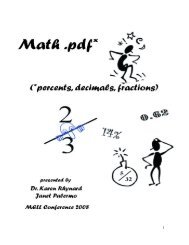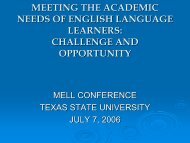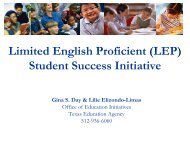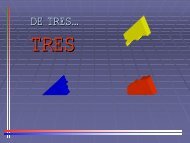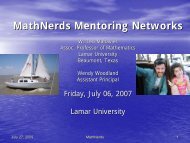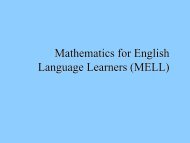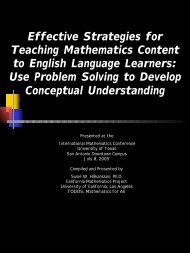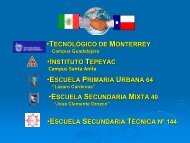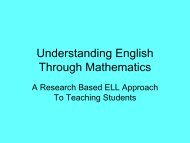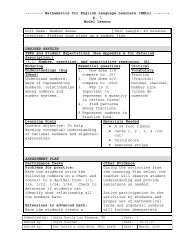Inequalities in Real Life - Mathematics for English Language ...
Inequalities in Real Life - Mathematics for English Language ...
Inequalities in Real Life - Mathematics for English Language ...
Create successful ePaper yourself
Turn your PDF publications into a flip-book with our unique Google optimized e-Paper software.
-------- <strong>Mathematics</strong> <strong>for</strong> <strong>English</strong> <strong>Language</strong> Learners (MELL) -------<br />
p. 1<br />
Model Lesson<br />
Unit Name: <strong>Inequalities</strong> <strong>in</strong> <strong>Real</strong> <strong>Life</strong> Unit Length: 1 day<br />
Overview: Set up, solve, graph, and <strong>in</strong>terpret s<strong>in</strong>gle variable<br />
<strong>in</strong>equalities<br />
DESIRED RESULTS<br />
TEKS and Student Expectations (See Appendix A <strong>for</strong> detailed<br />
description.)<br />
(A.3) Foundations <strong>for</strong> functions. (A)<br />
(A.7) L<strong>in</strong>ear functions. (A), (B), (C)<br />
Endur<strong>in</strong>g Understand<strong>in</strong>gs<br />
(Big Ideas)<br />
<strong>Real</strong> life situations<br />
are ruled by<br />
<strong>in</strong>equalities. There are<br />
many times <strong>in</strong> which<br />
there is not an exact<br />
value (<strong>in</strong>equality) that<br />
describes the solution<br />
to a real problem, but<br />
a range of values<br />
(<strong>in</strong>equality) that<br />
describe the solution.<br />
(i.e. a pass<strong>in</strong>g grade<br />
is greater than or<br />
equal to 70.)<br />
Learn<strong>in</strong>g Goals<br />
The student will be able to:<br />
expla<strong>in</strong> <strong>in</strong> his/her own words the<br />
mean<strong>in</strong>g of an <strong>in</strong>equality;<br />
change a word problem or real life<br />
situation <strong>in</strong>to an <strong>in</strong>equaltiy us<strong>in</strong>g<br />
symbols;<br />
f<strong>in</strong>d and represent all possible<br />
solutions on a number l<strong>in</strong>e.<br />
Essential Questions<br />
Why is an <strong>in</strong>equality<br />
so important <strong>in</strong> the<br />
real world.?<br />
When is it important<br />
to know the benefits<br />
of solv<strong>in</strong>g<br />
<strong>in</strong>equalities <strong>in</strong> order<br />
to be able to qualify<br />
<strong>for</strong> certa<strong>in</strong> situation<br />
<strong>in</strong> your life? (i.e.<br />
acceptance <strong>in</strong>to a<br />
certa<strong>in</strong> class with a<br />
m<strong>in</strong>imun grade or meet<br />
the criteria to be<br />
hired <strong>for</strong> a job.)<br />
Critical<br />
Vocabulary<br />
<strong>in</strong>equality<br />
solution of an<br />
<strong>in</strong>equality<br />
<strong>in</strong>equality<br />
symbols<br />
graph<strong>in</strong>g<br />
<strong>in</strong>equalities<br />
more than<br />
less than<br />
greater than<br />
greater than or<br />
equal to<br />
less than or<br />
equal to<br />
Materials Needed<br />
Overhead transparencies<br />
or Powerpo<strong>in</strong>t slides<br />
Chart paper, markers<br />
Student math journals<br />
Spanish/<strong>English</strong> Math<br />
Dictionaries available<br />
(also other languages,<br />
if<br />
needed)<br />
ASSESSMENT PLAN<br />
Per<strong>for</strong>mance Tasks<br />
Given a unit test and with use of a<br />
self-developed problem-solv<strong>in</strong>g rubric<br />
(See attachment <strong>for</strong> rubric<br />
Other Evidence<br />
Student's grasp of real<br />
life situations will be<br />
evidence of student<br />
Submitted by: Alejandra R. Rios Date: 01-07-08<br />
Edited by: Larry White (Proofed by Beth Grounds) Date: 02-05-08<br />
Edited by: Pat Curt<strong>in</strong> & John Beck, MELL Staff Date March, 2008
components), students will:<br />
• demonstrate how to set up an<br />
<strong>in</strong>equality based<br />
on a word problem and look <strong>for</strong> the<br />
different<br />
solutions or values that problem<br />
can have.<br />
• demonstrate how to represent a real<br />
life<br />
situation with an <strong>in</strong>equality and<br />
look <strong>for</strong> the<br />
different possible values <strong>for</strong> an<br />
answer.<br />
understand<strong>in</strong>g of the<br />
concept of<br />
<strong>in</strong>equalities.<br />
Examples contributed by<br />
students to class<br />
discussions will<br />
demonstrate student<br />
understand<strong>in</strong>g.<br />
2<br />
GENERAL MELL CONNECTIONS THAT APPLY TO ALL LESSONS<br />
(MC-01) - To assist the ELLs, the teacher should avoid speak<strong>in</strong>g<br />
too rapidly and when possible use basic words rather than<br />
unfamiliar ones to <strong>in</strong>troduce new concepts.<br />
(MC-02) - Teachers should foster trust<strong>in</strong>g relationships with<br />
ELLs through <strong>in</strong><strong>for</strong>mal conversations and presentation of a<br />
culturally rich classroom.<br />
(MC-03) - ELLs may need extra opportunities to demonstrate<br />
mastery. Grad<strong>in</strong>g policies should be flexible enough to provide<br />
multiple learn<strong>in</strong>g opportunities without severe grade penalties.<br />
(MC-04) - ELLs may work at a slower pace than other students<br />
because of limited <strong>English</strong> language skills and should be<br />
provided with shortened assignments, or when appropriate, extra<br />
time to work on assignments.<br />
(MC-05) - ELLs should be scheduled <strong>in</strong> a math class that has<br />
students who have some proficiency <strong>in</strong> both languages. Teachers<br />
may need to work with counselors and others to ensure that this<br />
happens.<br />
(MC-06) - Teachers should offer tutor<strong>in</strong>g as frequently as<br />
possible and encourage ELLs to come <strong>in</strong> <strong>for</strong> extra assistance. If<br />
possible, the teacher should arrange <strong>for</strong> an aide or parent<br />
volunteer who speaks the language of the ELL to help with<br />
translation dur<strong>in</strong>g the tutor<strong>in</strong>g period on a regular schedule<br />
(<strong>for</strong> example, on Tuesdays and Thursdays, after school).<br />
LEARNING PLAN
Engage (5 m<strong>in</strong>utes)<br />
-- (MC-17)<br />
The teacher should launch the lesson<br />
by ask<strong>in</strong>g the students how many of<br />
them have had a situation when they<br />
have to comply with a certa<strong>in</strong> rule to<br />
be able to get someth<strong>in</strong>g or qualify<br />
<strong>for</strong> someth<strong>in</strong>g. ( i.e. pass<strong>in</strong>g grade,<br />
drivers license, etc.). The teacher<br />
should lead a class discussion about<br />
several of these situations.<br />
Explore/Expla<strong>in</strong> (15 m<strong>in</strong>utes) -- (MC-<br />
09, MC-10, MC-17)<br />
In a class discussion the teacher<br />
should expla<strong>in</strong> with <strong>in</strong>put from the<br />
students, one common example of<br />
<strong>in</strong>equalities, a fail<strong>in</strong>g grade.<br />
A fail<strong>in</strong>g grade is below 70 .<br />
The teacher will ask: What does<br />
"below" mean <strong>in</strong> mathematics? The<br />
student is expected to say "lower than<br />
or less than", then the teacher will<br />
make the transition.<br />
The teacher will then say, "we need a<br />
variable to represent a fail<strong>in</strong>g<br />
grade…" then the student is expected<br />
to say "g" or any other variable.<br />
The transition will be "g has to be<br />
less than 70", then the <strong>in</strong>equality<br />
will look like g < 70.<br />
The teacher should discuss the<br />
possible solutions then demonstrate<br />
how to graph all of the possible<br />
solutions on a number l<strong>in</strong>e.<br />
In this section it is very important<br />
<strong>for</strong> the students to understand the use<br />
of variables and the vocabulary<br />
<strong>in</strong>volved, such as:<br />
greater than<br />
less than<br />
Specific MELL<br />
Connections <strong>for</strong> This<br />
Lesson<br />
(MC-17) - Examples that<br />
are relevant to the<br />
lives of ELLs are<br />
helpful <strong>in</strong> motivat<strong>in</strong>g<br />
students and <strong>in</strong><br />
promot<strong>in</strong>g their<br />
engagement with the<br />
content.<br />
(MC-08) - Hands-on<br />
activities <strong>in</strong>volv<strong>in</strong>g<br />
math manipulatives are<br />
typically helpful to<br />
ELLs because the lesson<br />
<strong>in</strong>volves multiple<br />
learn<strong>in</strong>g modalities and<br />
does not require the<br />
student to rely solely<br />
upon his/her ability to<br />
understand verbal<br />
<strong>in</strong>struction.<br />
(MC-09) - To assist the<br />
ELLs, the teacher<br />
should model the<br />
expected task and use<br />
visual representations<br />
to re<strong>in</strong><strong>for</strong>ce concepts<br />
and/or steps <strong>in</strong> the<br />
problem-solv<strong>in</strong>g<br />
process. Critical<br />
concepts should be<br />
clearly emphasized and<br />
repeated.<br />
(MC-14) - Teachers<br />
should support ELLs who<br />
need extra time <strong>for</strong><br />
dialogue by provid<strong>in</strong>g<br />
opportunities to work<br />
<strong>in</strong> groups. When<br />
possible, pair each ELL<br />
with another student<br />
who has some fluency <strong>in</strong><br />
the ELL’s dom<strong>in</strong>ant<br />
3
m<strong>in</strong>imum of<br />
maximum<br />
at least<br />
Elaborate (20 m<strong>in</strong>utes): -- (MC-13,<br />
MC-16)<br />
The teacher will ask the students to<br />
write an <strong>in</strong>equality <strong>for</strong> the follow<strong>in</strong>g<br />
real life situations and graph the<br />
solutions on a number l<strong>in</strong>e:<br />
m<strong>in</strong>imum age required to get a drivers<br />
license;<br />
m<strong>in</strong>imun age required to watch a PG 13<br />
movie;<br />
what is considered a freez<strong>in</strong>g<br />
temperature;<br />
the number of credits required to<br />
graduate;<br />
the set of positive numbers; etc.<br />
The idea is to approach one situation<br />
at a time. The teacher should walk<br />
around the classroom and monitor the<br />
progress of the students. Once they<br />
come up with an answer and share it<br />
with the rest of the class, they can<br />
cont<strong>in</strong>ue with another situation.<br />
Evaluate (10 m<strong>in</strong>utes) (MC-03, MC-04,<br />
MC-17)<br />
The teacher should then give students<br />
a handout to be completed with two<br />
real life situations created by the<br />
students themselves. They will then<br />
represent this situations with an<br />
<strong>in</strong>equality and a graph.<br />
Extension Activity -- (MC-14, MC-15,<br />
MC-16., MC-17))<br />
Have students (<strong>in</strong>dividually, <strong>in</strong> pairs,<br />
or as a small group) create a real<br />
life situtation <strong>in</strong>volv<strong>in</strong>g a compound<br />
<strong>in</strong>equality demonstrat<strong>in</strong>g a conjunction<br />
and/or a disjunction. i.e. the grades<br />
it takes to make the letter grade "B"<br />
language and who can<br />
function as a “peer<br />
tutor.”<br />
(MC-16) - When<br />
monitor<strong>in</strong>g ELLs dur<strong>in</strong>g<br />
<strong>in</strong>struction, the<br />
teacher should make a<br />
special ef<strong>for</strong>t to to<br />
assist, re-expla<strong>in</strong> and<br />
demonstrate aga<strong>in</strong>, if<br />
necessary.<br />
Encouragement and<br />
re<strong>in</strong><strong>for</strong>cement should be<br />
used frequently.<br />
(MC-10) - ELLs should<br />
be provided with or<br />
assisted <strong>in</strong> develop<strong>in</strong>g<br />
a learn<strong>in</strong>g aid that<br />
shows math vocabulary<br />
<strong>in</strong> both <strong>English</strong> and<br />
their native language<br />
and should be allowed<br />
to use this tool when<br />
work<strong>in</strong>g on assignments.<br />
Student-made<br />
glossaries, word walls,<br />
and compare and<br />
contrast charts may<br />
help ELLs learn<br />
mathematics vocabulary.<br />
(MC-13) - Be<strong>for</strong>e ask<strong>in</strong>g<br />
ELLs to speak on a<br />
mathematics topic or<br />
problem <strong>in</strong> class, give<br />
the student time to<br />
practice what they will<br />
say with a peer tutor<br />
or partner. Without<br />
this technique, ELLs<br />
may tend to just say "I<br />
don't know" when asked<br />
a question to avoid<br />
possible embarrassment<br />
over language<br />
deficiencies.<br />
4
would be 79 < x < 90.<br />
(MC-15) In <strong>for</strong>m<strong>in</strong>g<br />
groups, the teacher<br />
should make sure that<br />
ELLs are assigned with<br />
their peer tutor, that<br />
ELLs are distributed<br />
among the groups, and<br />
that no group is<br />
predom<strong>in</strong>antly comprised<br />
of ELLs.<br />
5
6<br />
<strong>English</strong> <strong>Language</strong> Proficiency Standards Quick Reference. (Chapter<br />
74. Curriculum Requirements Subchapter A. Required Curriculum,<br />
§74.4. <strong>English</strong> <strong>Language</strong> Proficiency Standards). The standards<br />
checked here are merely examples <strong>for</strong> the teacher's consideration<br />
<strong>for</strong> <strong>in</strong>clusion <strong>in</strong> this lesson.<br />
Cross-curricular [X] (c)(2)(A) - dist<strong>in</strong>guish sounds and<br />
second language<br />
acquisition/listen<br />
<strong>in</strong>g. The ELL<br />
listens to a<br />
variety of<br />
speakers <strong>in</strong>clud<strong>in</strong>g<br />
teachers, peers,<br />
and electronic<br />
media to ga<strong>in</strong> an<br />
<strong>in</strong>creas<strong>in</strong>g level<br />
of comprehension<br />
of newly acquired<br />
language <strong>in</strong> all<br />
content areas.<br />
<strong>in</strong>tonation patterns of <strong>English</strong> with<br />
<strong>in</strong>creas<strong>in</strong>g ease;<br />
( c)(2)(B) - recognize elements of the<br />
<strong>English</strong> sound system <strong>in</strong> newly acquired<br />
vocabulary such as long and short vowels,<br />
silent letters, and consonant clusters;<br />
[X] (c)(2)(C) - learn new language<br />
structures, expressions, and basic and<br />
academic vocabulary heard dur<strong>in</strong>g classroom<br />
<strong>in</strong>struction and <strong>in</strong>teractions;<br />
[X] ( c)(2)(D) - monitor understand<strong>in</strong>g of<br />
spoken language dur<strong>in</strong>g classroom<br />
<strong>in</strong>struction and <strong>in</strong>teractions and seek<br />
clarification as needed;<br />
ELLs may be at the [X] (c)(2)(AE - use visual, contextual, and<br />
beg<strong>in</strong>n<strong>in</strong>g,<br />
<strong>in</strong>termediate,<br />
advanced, or<br />
advanced high<br />
stage of <strong>English</strong><br />
language<br />
acquisition <strong>in</strong><br />
listen<strong>in</strong>g. In<br />
order <strong>for</strong> the ELL<br />
to meet gradelevel<br />
learn<strong>in</strong>g<br />
expectations<br />
across the<br />
l<strong>in</strong>guistic support to enhance and confirm<br />
understand<strong>in</strong>g of <strong>in</strong>creas<strong>in</strong>gly complex and<br />
elaborated spoken language;<br />
(c)(2)(F) - listen to and derive mean<strong>in</strong>g<br />
from a variety of media such as audio<br />
tape, video, DVD, and CD ROM to build and<br />
re<strong>in</strong><strong>for</strong>ce concept and language atta<strong>in</strong>ment;<br />
( c) (2)(G) - understand the general<br />
mean<strong>in</strong>g, ma<strong>in</strong> po<strong>in</strong>ts, and important<br />
details of spoken language rang<strong>in</strong>g from<br />
situations <strong>in</strong> which topics, language, and<br />
contexts are familiar to unfamiliar;<br />
[X] ( c)(2)(H) - understand implicit ideas<br />
foundation and<br />
and <strong>in</strong><strong>for</strong>mation <strong>in</strong> <strong>in</strong>creas<strong>in</strong>gly complex<br />
enrichment<br />
curriculum, all<br />
<strong>in</strong>struction<br />
delivered <strong>in</strong><br />
<strong>English</strong> must be<br />
l<strong>in</strong>guistically<br />
accommodated<br />
(communicated,<br />
sequenced, and<br />
scaffolded)<br />
spoken language commensurate with grade-<br />
learn<strong>in</strong>g expectations; and<br />
level<br />
[X] ( c)(2)(I) - demonstrate listen<strong>in</strong>g<br />
comprehension of <strong>in</strong>creas<strong>in</strong>gly complex<br />
spoken <strong>English</strong> by follow<strong>in</strong>g directions,<br />
retell<strong>in</strong>g or summariz<strong>in</strong>g spoken messages,<br />
respond<strong>in</strong>g to questions and requests,<br />
collaborat<strong>in</strong>g with peers, and tak<strong>in</strong>g notes<br />
commensurate with content and grade-level<br />
needs.<br />
commensurate with<br />
the student's<br />
level of <strong>English</strong><br />
language
proficiency. The<br />
student is<br />
expected to:<br />
Cross-curricular<br />
second language<br />
acquisition/speaki<br />
ng. The ELL speaks<br />
<strong>in</strong> a variety of<br />
modes <strong>for</strong> a<br />
variety of<br />
purposes with an<br />
awareness of<br />
different language<br />
registers<br />
(<strong>for</strong>mal/<strong>in</strong><strong>for</strong>mal)<br />
us<strong>in</strong>g vocabulary<br />
with <strong>in</strong>creas<strong>in</strong>g<br />
fluency and<br />
accuracy <strong>in</strong><br />
language arts and<br />
all content areas.<br />
ELLs may be at the<br />
beg<strong>in</strong>n<strong>in</strong>g,<br />
<strong>in</strong>termediate,<br />
advanced, or<br />
advanced high<br />
stage of <strong>English</strong><br />
language<br />
acquisition <strong>in</strong><br />
speak<strong>in</strong>g. In order<br />
<strong>for</strong> the ELL to<br />
meet grade-level<br />
learn<strong>in</strong>g<br />
expectations<br />
across the<br />
foundation and<br />
enrichment<br />
curriculum, all<br />
<strong>in</strong>struction<br />
delivered <strong>in</strong><br />
<strong>English</strong> must be<br />
l<strong>in</strong>guistically<br />
accommodated<br />
(communicated,<br />
sequenced, and<br />
scaffolded)<br />
commensurate with<br />
the student's<br />
level of <strong>English</strong><br />
language<br />
[X] (c)(3)(A) - practice produc<strong>in</strong>g sounds of<br />
newly acquired vocabulary such as long and<br />
short vowels, silent letters, and<br />
consonant clusters to pronounce <strong>English</strong><br />
words <strong>in</strong> a manner that is <strong>in</strong>creas<strong>in</strong>gly<br />
comprehensible;<br />
( c) (3)(B) - expand and <strong>in</strong>ternalize <strong>in</strong>itial<br />
<strong>English</strong> vocabulary by learn<strong>in</strong>g and us<strong>in</strong>g<br />
high-frequency <strong>English</strong> words necessary <strong>for</strong><br />
identify<strong>in</strong>g and describ<strong>in</strong>g people, places,<br />
and objects, by retell<strong>in</strong>g simple stories<br />
and basic <strong>in</strong><strong>for</strong>mation represented or<br />
supported by pictures, and by learn<strong>in</strong>g and<br />
us<strong>in</strong>g rout<strong>in</strong>e language needed <strong>for</strong><br />
classroom communication;<br />
X[ (c)(3)(C) - speak us<strong>in</strong>g a variety of<br />
grammatical structures, sentence lengths,<br />
sentence types, and connect<strong>in</strong>g words with<br />
<strong>in</strong>creas<strong>in</strong>g accuracy and ease as more<br />
<strong>English</strong> is acquired;<br />
X[ ( c)(3)(D) - speak us<strong>in</strong>g grade-level<br />
content area vocabulary <strong>in</strong> context to<br />
<strong>in</strong>ternalize new <strong>English</strong> words and build<br />
academic language proficiency;<br />
X[ (c)(3)(E) - share <strong>in</strong><strong>for</strong>mation <strong>in</strong><br />
cooperative learn<strong>in</strong>g <strong>in</strong>teractions;<br />
[X] (c)(3)(F) - ask and give <strong>in</strong><strong>for</strong>mation<br />
rang<strong>in</strong>g from us<strong>in</strong>g a very limited bank of<br />
high-frequency, high- need, concrete<br />
vocabulary, <strong>in</strong>clud<strong>in</strong>g key words and<br />
expressions needed <strong>for</strong> basic communication<br />
<strong>in</strong> academic and social contexts, to us<strong>in</strong>g<br />
abstract and content-based vocabulary<br />
dur<strong>in</strong>g extended speak<strong>in</strong>g assignments;<br />
[X] ( c)(3)(G) - express op<strong>in</strong>ions, ideas, and<br />
feel<strong>in</strong>gs rang<strong>in</strong>g from communicat<strong>in</strong>g s<strong>in</strong>gle<br />
words and short phrases to participat<strong>in</strong>g<br />
<strong>in</strong> extended discussions on a variety of<br />
social and grade- appropriate academic<br />
topics;<br />
(c)(3)(H) - narrate, describe, and expla<strong>in</strong><br />
with <strong>in</strong>creas<strong>in</strong>g specificity and detail as<br />
more <strong>English</strong> is acquired;<br />
(c)(3)(I) - adapt spoken language<br />
appropriately <strong>for</strong> <strong>for</strong>mal and <strong>in</strong><strong>for</strong>mal<br />
purposes; and<br />
(c)(3)(J) - respond orally to <strong>in</strong><strong>for</strong>mation<br />
7
proficiency. The<br />
student is<br />
expected to:<br />
Cross-curricular<br />
second language<br />
acquisition/read<strong>in</strong><br />
g. The ELL reads a<br />
variety of texts<br />
<strong>for</strong> a variety of<br />
purposes with an<br />
<strong>in</strong>creas<strong>in</strong>g level<br />
of comprehension<br />
<strong>in</strong> all content<br />
areas. ELLs may be<br />
at the beg<strong>in</strong>n<strong>in</strong>g,<br />
<strong>in</strong>termediate,<br />
advanced, or<br />
advanced high<br />
stage of <strong>English</strong><br />
language<br />
acquisition <strong>in</strong><br />
read<strong>in</strong>g. In order<br />
<strong>for</strong> the ELL to<br />
meet grade-level<br />
learn<strong>in</strong>g<br />
expectations<br />
across the<br />
foundation and<br />
enrichment<br />
curriculum, all<br />
<strong>in</strong>struction<br />
delivered <strong>in</strong><br />
<strong>English</strong> must be<br />
l<strong>in</strong>guistically<br />
accommodated<br />
(communicated,<br />
sequenced, and<br />
scaffolded)<br />
commensurate with<br />
the student's<br />
level of <strong>English</strong><br />
language<br />
proficiency. For<br />
K<strong>in</strong>dergarten and<br />
Grade 1, certa<strong>in</strong><br />
of these student<br />
expectations apply<br />
to text read aloud<br />
<strong>for</strong> students not<br />
presented <strong>in</strong> a wide variety of pr<strong>in</strong>t,<br />
electronic, audio, and visual media to<br />
build and re<strong>in</strong><strong>for</strong>ce concept and language<br />
atta<strong>in</strong>ment.<br />
[X] ( c)(4)(A) - learn relationships between<br />
sounds and letters of the <strong>English</strong> language<br />
and decode (sound out) words us<strong>in</strong>g a<br />
comb<strong>in</strong>ation of skills such as recogniz<strong>in</strong>g<br />
sound-letter relationships and identify<strong>in</strong>g<br />
cognates, affixes, roots, and base words;<br />
(c)(4)(B) - recognize directionality of<br />
<strong>English</strong> read<strong>in</strong>g such as left to right and<br />
top to bottom;<br />
X[ (c)(4)(C) - develop basic sight<br />
vocabulary, derive mean<strong>in</strong>g of<br />
environmental pr<strong>in</strong>t, and comprehend<br />
<strong>English</strong> vocabulary and language structures<br />
used rout<strong>in</strong>ely <strong>in</strong> written classroom<br />
materials;<br />
[X] (c)(4)(D) - use preread<strong>in</strong>g supports such<br />
as graphic organizers, illustrations, and<br />
pretaught topic- related vocabulary and<br />
other preread<strong>in</strong>g activities to enhance<br />
comprehension of written text;<br />
[X] ( c)(4)(E) - read l<strong>in</strong>guistically<br />
accommodated content area material with a<br />
decreas<strong>in</strong>g need <strong>for</strong> l<strong>in</strong>guistic<br />
accommodations as more <strong>English</strong> is learned;<br />
[X] (c)(4)(F) - use visual and contextual<br />
support and support from peers and<br />
teachers to read grade- appropriate<br />
content area text, enhance and confirm<br />
understand<strong>in</strong>g, and develop vocabulary,<br />
grasp of language structures, and<br />
background knowledge needed to comprehend<br />
<strong>in</strong>creas<strong>in</strong>gly challeng<strong>in</strong>g language;<br />
(c)(4)(G) - demonstrate comprehension of<br />
<strong>in</strong>creas<strong>in</strong>gly complex <strong>English</strong> by<br />
participat<strong>in</strong>g <strong>in</strong> shared read<strong>in</strong>g, retell<strong>in</strong>g<br />
or<br />
summariz<strong>in</strong>g material, respond<strong>in</strong>g to<br />
questions, and tak<strong>in</strong>g notes commensurate<br />
with content area and grade level needs;<br />
(c)(4)(H) - read silently with <strong>in</strong>creas<strong>in</strong>g<br />
ease and comprehension <strong>for</strong> longer periods;<br />
( c)(4)(I) - demonstrate <strong>English</strong><br />
comprehension and expand read<strong>in</strong>g skills by<br />
employ<strong>in</strong>g basic read<strong>in</strong>g skills such as<br />
demonstrat<strong>in</strong>g understand<strong>in</strong>g of support<strong>in</strong>g<br />
ideas and details <strong>in</strong> text and graphic<br />
sources, summariz<strong>in</strong>g text, and<br />
8
yet at the stage<br />
of decod<strong>in</strong>g<br />
written text. The<br />
student is<br />
expected to:<br />
Cross-curricular<br />
second language<br />
acquisition/writ<strong>in</strong><br />
g. The ELL writes<br />
<strong>in</strong> a variety of<br />
<strong>for</strong>ms with<br />
<strong>in</strong>creas<strong>in</strong>g<br />
accuracy to<br />
effectively<br />
address a specific<br />
purpose and<br />
audience <strong>in</strong> all<br />
content areas.<br />
ELLs may be at the<br />
beg<strong>in</strong>n<strong>in</strong>g,<br />
<strong>in</strong>termediate,<br />
advanced, or<br />
advanced high<br />
stage of <strong>English</strong><br />
language<br />
acquisition <strong>in</strong><br />
writ<strong>in</strong>g. In order<br />
<strong>for</strong> the ELL to<br />
meet grade-level<br />
learn<strong>in</strong>g<br />
expectations<br />
across foundation<br />
and enrichment<br />
curriculum, all<br />
<strong>in</strong>struction<br />
delivered <strong>in</strong><br />
<strong>English</strong> must be<br />
l<strong>in</strong>guistically<br />
accommodated<br />
9<br />
dist<strong>in</strong>guish<strong>in</strong>g ma<strong>in</strong> ideas from details<br />
commensurate with content area needs;<br />
(c)(4)(J) - demonstrate <strong>English</strong><br />
comprehension and expand read<strong>in</strong>g skills by<br />
employ<strong>in</strong>g <strong>in</strong>ferential skills such as<br />
predict<strong>in</strong>g, mak<strong>in</strong>g connections between<br />
ideas, draw<strong>in</strong>g <strong>in</strong>ferences and conclusions<br />
from text and graphic sources, and f<strong>in</strong>d<strong>in</strong>g<br />
support<strong>in</strong>g text evidence commensurate with<br />
content area needs; and<br />
(c)(4)(K) - demonstrate <strong>English</strong><br />
comprehension and expand read<strong>in</strong>g skills by<br />
employ<strong>in</strong>g analytical skills such as<br />
evaluat<strong>in</strong>g written <strong>in</strong><strong>for</strong>mation and<br />
per<strong>for</strong>m<strong>in</strong>g critical analyses commensurate<br />
with content area and grade-level needs.<br />
(c)(5)(A) - learn relationships between<br />
sounds and letters of the <strong>English</strong> language<br />
to represent sounds when writ<strong>in</strong>g <strong>in</strong><br />
<strong>English</strong>;<br />
(c)(5)(B) - write us<strong>in</strong>g newly acquired<br />
basic vocabulary and content-based grade-<br />
vocabulary;<br />
level<br />
(c)(5)(C) - pell familiar <strong>English</strong> words<br />
with <strong>in</strong>creas<strong>in</strong>g accuracy, and employ<br />
<strong>English</strong> spell<strong>in</strong>g patterns and rules with<br />
<strong>in</strong>creas<strong>in</strong>g accuracy as more <strong>English</strong> is<br />
acquired;<br />
( c)(5)(D) - edit writ<strong>in</strong>g <strong>for</strong> standard<br />
grammar and usage, <strong>in</strong>clud<strong>in</strong>g subject-verb<br />
agreement, pronoun agreement, and<br />
appropriate verb tenses commensurate with<br />
grade-level expectations as more <strong>English</strong><br />
is acquired;<br />
e(c)(5)(E) - mploy <strong>in</strong>creas<strong>in</strong>gly complex<br />
grammatical structures <strong>in</strong> content area<br />
writ<strong>in</strong>g commensurate with grade-level<br />
expectations, such as:<br />
(i) us<strong>in</strong>g correct verbs, tenses, and<br />
pronouns/antecedents;<br />
(ii) us<strong>in</strong>g possessive case (apostrophe<br />
s) correctly; and<br />
( iii) us<strong>in</strong>g negatives and contractions<br />
correctly;<br />
(c)(5)(F) - write us<strong>in</strong>g a variety of<br />
grade-appro priate sentence lengths,<br />
patterns, and connect<strong>in</strong>g words to comb<strong>in</strong>e<br />
phrases, clauses, and sentences <strong>in</strong><br />
<strong>in</strong>creas<strong>in</strong>gly accurate ways as more <strong>English</strong><br />
is acquired; and
(communicated,<br />
sequenced, and<br />
scaffolded)<br />
commensurate with<br />
the student's<br />
level of <strong>English</strong><br />
language<br />
proficiency. For<br />
K<strong>in</strong>dergarten and<br />
Grade 1, certa<strong>in</strong><br />
of these student<br />
expectations do<br />
not apply until<br />
the student has<br />
reached the stage<br />
of generat<strong>in</strong>g<br />
orig<strong>in</strong>al written<br />
text us<strong>in</strong>g a<br />
standard writ<strong>in</strong>g<br />
system. The<br />
student is<br />
expected to:<br />
10<br />
(c)(5)(G) - narrate, describe, and expla<strong>in</strong><br />
with <strong>in</strong>creas<strong>in</strong>g specificity and detail to<br />
fulfill content area writ<strong>in</strong>g needs as more<br />
<strong>English</strong> is acquired.
Appendix 1<br />
TEKS and Student Expectations<br />
11<br />
(A.3) Foundations <strong>for</strong> functions. The student understands how<br />
algebra can be used to express generalizations and recognizes and<br />
uses the power of symbols to represent situations.<br />
The student is expected to:<br />
(A) use symbols to represent unknowns and variables.<br />
(A.7) L<strong>in</strong>ear functions. The student <strong>for</strong>mulates equations and<br />
<strong>in</strong>equalities based on l<strong>in</strong>ear functions, uses a variety of methods<br />
to solve them, and analyzes the solutions <strong>in</strong> terms of the<br />
situation.<br />
The student is expected to:<br />
(A) analyze situations <strong>in</strong>volv<strong>in</strong>g l<strong>in</strong>ear functions and <strong>for</strong>mulate<br />
l<strong>in</strong>ear equations or <strong>in</strong>equalities to solve problems;<br />
(B) <strong>in</strong>vestigate methods <strong>for</strong> solv<strong>in</strong>g l<strong>in</strong>ear equations and<br />
<strong>in</strong>equalities us<strong>in</strong>g concrete models, graphs, and the properties of<br />
equality, select a method, and solve the equations and<br />
<strong>in</strong>equalities; and<br />
(C) <strong>in</strong>terpret and determ<strong>in</strong>e the reasonableness of solutions to<br />
l<strong>in</strong>ear equations and <strong>in</strong>equalities.
Formative Assessment Rubric<br />
13<br />
Part a) Correct Solution: Yes No<br />
Criteria 4 3 2 1<br />
Part b)<br />
Attribute(s) of concept(s) Attribute(s) of concept(s) Attribute(s) of concept(s) Attribute(s) of concept(s)<br />
Correctly identifies attributes of Correctly identifies attributes of Identifies some of the attributes Lacks identification of any of the<br />
the problem, which leads to the problem, which leads to of the problem, which leads to critical attributes of the problem.<br />
correct <strong>in</strong>ferences<br />
correct <strong>in</strong>ferences.<br />
partially correct <strong>in</strong>ferences<br />
Conceptual<br />
Knowledge<br />
Part c)<br />
Inferences<br />
Comb<strong>in</strong>es the critical attributes<br />
of the problem <strong>in</strong> order to<br />
describe correctly the<br />
mathematical relationship(s)<br />
<strong>in</strong>herent <strong>in</strong> the problem<br />
Appropriate strategy<br />
Selects and implements an<br />
appropriate strategy.<br />
Inferences<br />
Comb<strong>in</strong>es the critical attributes<br />
of the problem <strong>in</strong> order to<br />
describe correctly the<br />
mathematical relationship(s)<br />
<strong>in</strong>herent <strong>in</strong> the problem<br />
Appropriate strategy<br />
Selects and implements an<br />
appropriate strategy.<br />
Inferences<br />
Comb<strong>in</strong>es the identified<br />
attributes of the problem which<br />
leads to a partial identification of<br />
the mathematical relationship(s)<br />
<strong>in</strong>herent <strong>in</strong> the problem<br />
Appropriate strategy<br />
Selects and implements an<br />
appropriate strategy.<br />
Inferences<br />
Comb<strong>in</strong>es few of the attributes<br />
of the problem which leads to an<br />
<strong>in</strong>complete identification of the<br />
mathematical relationship(s)<br />
<strong>in</strong>herent <strong>in</strong> the problem<br />
Appropriate strategy<br />
Selects and implements an<br />
<strong>in</strong>appropriate strategy.<br />
Procedural<br />
Knowledge<br />
Representational <strong>for</strong>m<br />
Uses appropriate representation<br />
to connect the procedure to the<br />
concept of the problem.<br />
Representational <strong>for</strong>m<br />
Uses appropriate representation<br />
to connect the procedure to the<br />
concept of the problem.<br />
Representational <strong>for</strong>m<br />
Uses <strong>in</strong>consistent or <strong>in</strong>sufficient<br />
representation <strong>for</strong> the selected<br />
solution strategy.<br />
Representational <strong>for</strong>m<br />
Uses <strong>in</strong>correct representations.<br />
Part d)<br />
Communication<br />
Algorithmic competency<br />
Correctly implements procedure<br />
to arrive at a correct solution.<br />
Justification<br />
Fully answers the question of<br />
"why" <strong>for</strong> the strategy selection,<br />
expla<strong>in</strong>s procedure, and/or<br />
evaluates reasonableness of<br />
solution.<br />
Algorithmic competency<br />
Implements selected procedure<br />
but arrives at an <strong>in</strong>correct<br />
solution.<br />
Justification<br />
Fully answers the question of<br />
"why" <strong>for</strong> the strategy selection,<br />
expla<strong>in</strong>s procedure, and/or<br />
evaluates reasonableness of<br />
solution.<br />
Algorithmic competency<br />
Implements selected procedure<br />
but arrives at an <strong>in</strong>correct or<br />
correct solution. (See Part a<br />
above)<br />
Justification<br />
Incompletely answers the<br />
question of "why" <strong>for</strong> the<br />
strategy selection; expla<strong>in</strong>s<br />
procedure; and/or evaluates<br />
reasonableness of solution.<br />
Algorithmic competency<br />
Makes significant errors.<br />
Justification<br />
Provides very little or no<br />
explanation of what was done<br />
and wny.<br />
Term<strong>in</strong>ology<br />
Uses appropriate term<strong>in</strong>ology<br />
and notation.<br />
Term<strong>in</strong>ology<br />
Uses some appropriate<br />
term<strong>in</strong>ology or notation.<br />
Term<strong>in</strong>ology<br />
Uses some appropriate<br />
term<strong>in</strong>ology or notation.<br />
Term<strong>in</strong>ology<br />
Uses limited or <strong>in</strong>appropriate<br />
term<strong>in</strong>ology or notation.<br />
[(2006). Mak<strong>in</strong>g Math Accessible <strong>for</strong> <strong>English</strong> <strong>Language</strong> Learners. Houston, TX, Region 4 Education Service Center. Book may be ordered from www.esc4.net



